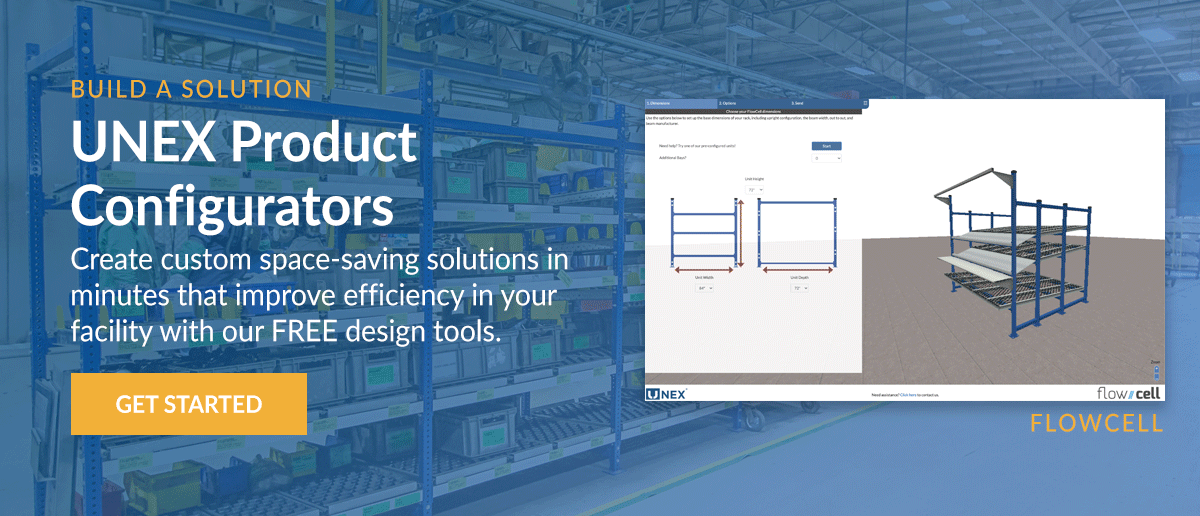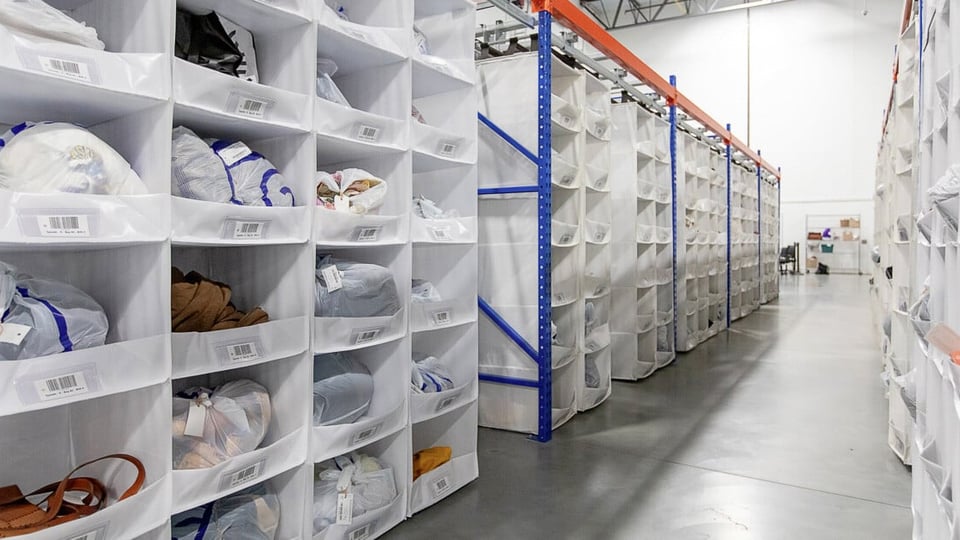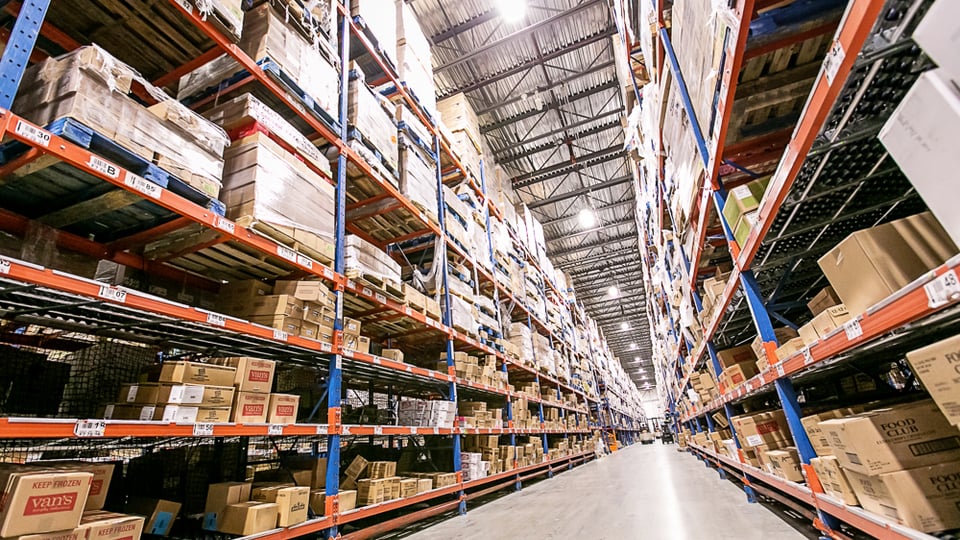How to Setup Micro-Fulfillment Centers for Faster Retail Operations

As eCommerce and omnichannel retail continue to redefine how consumers shop, the logistics behind getting products into customers’ hands have evolved rapidly. Retailers today are under pressure to fulfill online orders faster, cheaper, and closer to the end consumer. Enter the micro-fulfillment center, a small but mighty operational model that’s transforming retail and supply chain strategy across industries.
In this article, we’ll break down what a micro-fulfillment center is, why it’s growing so quickly, and how your organization can set one up in weeks, not months, with the right approach and equipment.
What Is a Micro-Fulfillment Center?
A micro-fulfillment center (MFC) is a compact, high-efficiency distribution hub located close to the end consumer, often within or attached to an existing retail store, backroom, or urban warehouse. By shrinking the traditional footprint of a regional distribution center, micro-fulfillment centers reduce delivery times, lower shipping costs, and streamline the last-mile logistics that make or break the customer experience.
Instead of operating a large, centralized warehouse that serves a vast region, retailers deploy micro-fulfillment centers to keep inventory close to key markets. These small, strategically located facilities use space optimization, dynamic storage systems, and efficient picking processes to maximize every square inch. These fulfillment operations are more often re-purposed areas or small additions to retail facilities. The idea being that retail stores already have some inventory, so why not re-purpose that inventory to serve more than traditional brick and mortar retail shoppers?
Retailers such as Target, Walmart, and Best Buy have already integrated micro-fulfillment centers into their omnichannel strategies, fulfilling online orders for local pickup, ship-from-store, or same-day delivery, all from within a few miles of their customers.

The Rapid Rise of Micro-Fulfillment
The surge in online shopping and customer expectations for instant gratification have accelerated demand for micro-fulfillment centers. Giants like Amazon and Instacart have set the standard for free and fast shipping, forcing other retailers to rethink traditional fulfillment models.
Beyond speed, micro-fulfillment addresses several critical business challenges:
-
Rising real estate costs: Smaller footprints mean lower rent and utilities.
-
Labor shortages: Streamlined layouts and ergonomic storage solutions help smaller teams work more efficiently.
-
Supply chain resilience: Distributing inventory across multiple locations reduces risk from disruptions like weather events or transportation delays.
-
Omnichannel integration: MFCs bridge the gap between eCommerce and brick-and-mortar operations, enabling seamless buy-online-pickup-in-store (BOPIS) and same-day delivery.
In short, micro-fulfillment isn’t just a logistics trend, it’s a competitive necessity.
Common Micro-Fulfillment Models
Retailers have embraced multiple micro-fulfillment models to balance customer expectations, operational efficiency, and profitability. The right model often depends on store layout, product mix, and regional demand, but all share one common goal: to bring inventory closer to the customer while keeping fulfillment fast and flexible.
1. In-Store Pickup and BOPIS (Buy Online, Pick Up In-Store)
In-store pickup, sometimes called BOPIS, has evolved into one of the most important micro-fulfillment strategies for retailers. It allows customers to shop online and pick up their orders at a designated counter, locker, or even curbside.
Retailers like Target, Walmart, and Lowe’s have refined this model into a science. At Target, for example, customers can order through the app, a team member fulfills the order directly from the store floor or backroom, and customers retrieve their purchase either at a pickup counter or via drive-up pickup, where associates bring items directly to the car.
This model gives shoppers immediate gratification without paying for shipping, while retailers benefit from increased store traffic and reduced last-mile costs.
However, effective BOPIS execution requires smart backroom optimization. Retailers now carve out dedicated micro-fulfillment zones within stores, areas outfitted with high-density storage, carton flow racks, and dynamic pick shelving to stage, organize, and fulfill orders efficiently. These spaces transform what was once backstock or overflow inventory into a productive, revenue-generating fulfillment engine.

2. Ship-From-Store
The ship-from-store model turns retail locations into localized distribution hubs. Instead of fulfilling online orders from distant regional warehouses, stores ship directly to nearby customers, reducing transit times and shipping costs.
This approach enables retailers to leverage store inventory as part of their online fulfillment strategy, preventing stockouts and improving turnover. Walmart, for example, uses data-driven systems to decide which stores fulfill online orders, routing shipments through the closest, best-stocked location.
From an operations standpoint, the key to success is space utilization and workflow design. Many retailers use carton flow systems to improve SKU accessibility and maintain FIFO rotation, especially in high-volume, fast-moving environments where fulfillment speed directly impacts customer satisfaction.
3. Local and Same-Day Delivery
For retailers competing with eCommerce giants like Amazon, same-day local delivery is the next frontier in micro-fulfillment. Instead of relying solely on shipping carriers, many have turned to gig-economy partners such as Shipt, DoorDash, or Instacart to handle the final mile.
In this model, store associates pick and stage orders in a dedicated fulfillment zone, where delivery drivers can easily access them. Time-to-door can be as short as an hour, transforming convenience into a differentiator.
To make this possible, stores need modular, flexible storage systems that accommodate fluctuating inventory volumes and rapid turnover. Dynamic storage solutions like high-density storage and gravity flow racks support quick access to SKUs while optimizing limited space. For retailers that need to adapt quickly to changing delivery demand, these systems make scaling up (or down) a matter of reconfiguration, not reconstruction.
Learn how to set up micro-fulfillment in a matter of weeks! Download the Quickstart Guide to Micro-fulfillment.
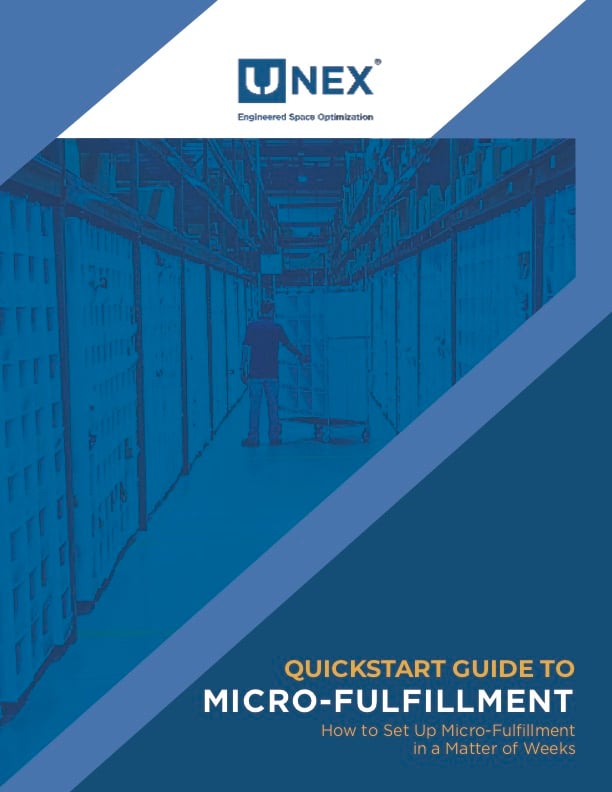
The Benefits of a Micro-Fulfillment Center
The value of a micro-fulfillment center goes far beyond faster shipping. It represents a strategic shift in how retailers think about space, labor, and the customer experience. As omnichannel shopping continues to blur the line between online and in-store, retailers must build fulfillment networks that can adapt instantly to fluctuating demand and customer preferences.
Micro-fulfillment centers deliver on that need by combining proximity, precision, and productivity. By positioning inventory closer to the customer and leveraging high-density, ergonomically designed storage systems, businesses can drastically improve their operational agility.
Here’s how leading retailers are realizing measurable gains:
1. Faster, More Predictable Delivery
In an era of “I-want-it-now” retail, proximity is power. By moving inventory from large, regional DCs to smaller local hubs, retailers reduce order-to-delivery times from days to hours. Orders that once sat in queue waiting for carrier pickup can now be fulfilled and delivered the same day, or even within the same shift. Retailers like Target and Best Buy have proven that MFCs can turn stores into last-mile engines, meeting rising consumer expectations without building costly new warehouses.
2. Reduced Shipping and Handling Costs
Shipping costs have skyrocketed as fuel prices, labor shortages, and customer expectations have increased. Micro-fulfillment centers minimize these costs by reducing the distance between product and consumer. Instead of paying for multiple touchpoints such as long-haul transport to stores, parcel shipping to customers, and restocking from regional DCs, retailers consolidate fulfillment closer to demand. That means fewer miles traveled, fewer touches, and lower last-mile delivery expenses.
At scale, this shift can yield millions in annual savings, all while improving service levels.
3. Maximized Space Utilization
Real estate costs continue to climb, making space the most valuable commodity in retail logistics. Micro-fulfillment centers are engineered to make every cubic foot count. By incorporating dynamic flow racks, modular workstations, and high-density storage, MFCs can hold significantly more SKUs in a smaller footprint while improving accessibility and pick efficiency.
4. Greater Accuracy and Throughput
Speed means nothing without accuracy. MFCs leverage modern storage design and visual organization to reduce picker travel time and error rates. Products are staged ergonomically, making them visible, reachable, and organized by velocity, which minimizes wasted motion and improves order accuracy. Fewer mis-picks mean happier customers, fewer returns, and stronger margins.
5. Enhanced Labor Productivity and Safety
Labor remains one of the most significant costs in fulfillment operations. Micro-fulfillment centers make it easier for small teams to do more with less by streamlining processes and improving ergonomics. By shortening pick paths and improving visibility, companies can reduce fatigue and injury risk while boosting morale and retention.
6. A Superior Customer Experience
Ultimately, every operational improvement feeds one outcome: a better customer experience. When retailers can promise faster delivery, offer flexible pickup options, and maintain inventory accuracy across channels, customer satisfaction rises, along with loyalty and lifetime value. Micro-fulfillment centers make this possible by creating a consistent, seamless fulfillment experience regardless of how or where the customer shops.

How to Set Up a Micro-Fulfillment Center in Weeks
Launching a micro-fulfillment center doesn’t have to mean starting from scratch. Many retailers can repurpose existing backrooms or small warehouse spaces by implementing efficient storage, organization, and fulfillment workflows.
Here’s how to make it happen fast:
-
Assess Your Existing Space: Identify underutilized areas such as retail backrooms, overstock sections, or small warehouse zones that can be converted into picking and staging areas.
-
Segment Inventory: Classify SKUs based on demand velocity, placing fast movers near the front and slow movers in high-density storage, to minimize picker travel and boost throughput.
-
Implement Dynamic Storage Solutions: Traditional static shelving wastes space and slows down operations. Instead, invest in dynamic storage solutions that optimize flow, such as carton flow racks, gravity conveyors, or modular pick shelves.
-
Train and Cross-Utilize Staff: Cross-train retail associates to handle in-store fulfillment tasks. Flexible staffing reduces downtime and ensures you can meet fluctuating order volumes.
-
Leverage Technology: Integrate order management and WMS systems that provide real-time inventory visibility across channels.
With the right partners and equipment, many retailers can implement an operational micro-fulfillment center in just a few weeks.
UNEX Solutions for Micro-Fulfillment Centers
At UNEX, we’ve spent decades engineering solutions that help retailers and 3PLs maximize space, improve flow, and accelerate order fulfillment. For micro-fulfillment centers, our systems deliver the flexibility, density, and speed you need to stay ahead.
SpeedCell High-Density Storage
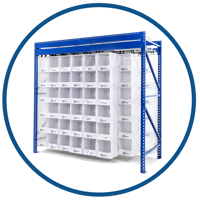 When floor space is limited but SKU counts are growing, SpeedCell creates order from chaos. Suspended from a patented steel track system, SpeedCell compresses 200 feet of static shelving into just 40 feet of organized, high-density storage. That means 40–60% more storage capacity in the same footprint. Each lightweight, flexible column provides quick access to small and medium SKUs, low-velocity pick zones in micro-fulfillment centers. SpeedCell reduces picker travel time by up to 40%, streamlining replenishment and order picking to keep products moving swiftly toward the customer.
When floor space is limited but SKU counts are growing, SpeedCell creates order from chaos. Suspended from a patented steel track system, SpeedCell compresses 200 feet of static shelving into just 40 feet of organized, high-density storage. That means 40–60% more storage capacity in the same footprint. Each lightweight, flexible column provides quick access to small and medium SKUs, low-velocity pick zones in micro-fulfillment centers. SpeedCell reduces picker travel time by up to 40%, streamlining replenishment and order picking to keep products moving swiftly toward the customer.
SpanTrack Carton Flow Racks
 SpanTrack carton flow racks are a cornerstone of dynamic storage design. SpanTrack drops easily into existing pallet racks to create smooth, reliable product flow for case-pick or each-pick operations. It’s engineered for speed and accuracy, ensuring that products automatically flow forward to the pick face for true FIFO (First-In, First-Out) inventory rotation. With options for roller lanes or wheel beds, SpanTrack provides the flexibility to accommodate products of varying sizes and weights.
SpanTrack carton flow racks are a cornerstone of dynamic storage design. SpanTrack drops easily into existing pallet racks to create smooth, reliable product flow for case-pick or each-pick operations. It’s engineered for speed and accuracy, ensuring that products automatically flow forward to the pick face for true FIFO (First-In, First-Out) inventory rotation. With options for roller lanes or wheel beds, SpanTrack provides the flexibility to accommodate products of varying sizes and weights.
Roller Rack Gravity Flow Racks
F or facilities that need a fast, turnkey setup, UNEX Roller Rack provides a complete, standalone carton flow solution. These pre-engineered racks combine durable SpanTrack flow beds with heavy-duty welded uprights and crossbeams, creating an all-in-one system ready to roll right into your operation. Roller Racks are ideal for micro-fulfillment environments where flexibility and speed of deployment are critical. They help operators stage, sort, and pick multiple orders simultaneously, all while maintaining FIFO organization and ergonomic reach points.
or facilities that need a fast, turnkey setup, UNEX Roller Rack provides a complete, standalone carton flow solution. These pre-engineered racks combine durable SpanTrack flow beds with heavy-duty welded uprights and crossbeams, creating an all-in-one system ready to roll right into your operation. Roller Racks are ideal for micro-fulfillment environments where flexibility and speed of deployment are critical. They help operators stage, sort, and pick multiple orders simultaneously, all while maintaining FIFO organization and ergonomic reach points.
FlowCell Modular Workstations
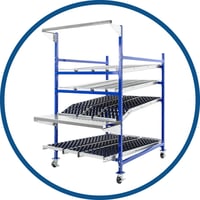 In micro-fulfillment centers, the picking process doesn’t end at the shelf, it continues through packing, staging, and outbound sorting. UNEX FlowCell workstations support this critical step by providing ergonomic, modular workstations where associates can pack, label, or sort orders efficiently. FlowCell workstations are built from durable, heavy-gauge steel and feature angled pick levels to bring products within easy reach, reducing bending, reaching, and fatigue. Their modular design allows you to add accessories like toolbars, work surfaces, or pick trays to fulfillment stations.
In micro-fulfillment centers, the picking process doesn’t end at the shelf, it continues through packing, staging, and outbound sorting. UNEX FlowCell workstations support this critical step by providing ergonomic, modular workstations where associates can pack, label, or sort orders efficiently. FlowCell workstations are built from durable, heavy-gauge steel and feature angled pick levels to bring products within easy reach, reducing bending, reaching, and fatigue. Their modular design allows you to add accessories like toolbars, work surfaces, or pick trays to fulfillment stations.
Together, these solutions create micro-fulfillment environments that are flexible, ergonomic, and lightning-fast, enabling you to meet customer demand without expanding your footprint.
The Future of Fulfillment Is Micro
Micro-fulfillment centers represent a major shift in how companies approach logistics — smaller, smarter, and closer to the customer. With the right design, equipment, and strategy, you can implement a micro-fulfillment model that accelerates order delivery, lowers costs, and delights your customers.
Creating an in-store or backroom micro-fulfillment center may be easier than you think. With UNEX SpeedCell, SpanTrack, and Roller Rack, you can build efficient, scalable systems that bring your inventory closer to the customer, and your business closer to success.
Contact UNEX today to learn how we can help you design a high-performing micro-fulfillment center that fits your unique needs.

